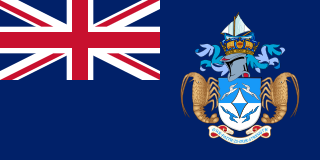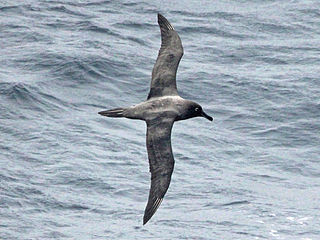
Tristan da Cunha, colloquially Tristan, is a remote group of volcanic islands in the south Atlantic Ocean. It is the most remote inhabited archipelago in the world, lying approximately 1,732 miles (2,787 km) off the coast of Cape Town in South Africa, 1,514 miles (2,437 km) from Saint Helena and 2,487 miles (4,002 km) off the coast of the Falkland Islands.

The white-faced storm petrel, also known as white-faced petrel is a small seabird of the austral storm petrel family Oceanitidae. It is the only member of the monotypic genus Pelagodroma.

Gough Island, also known historically as Gonçalo Álvares after the Portuguese explorer, is a rugged volcanic island in the South Atlantic Ocean. It is a dependency of Tristan da Cunha and part of the British overseas territory of Saint Helena, Ascension and Tristan da Cunha. It is about 400 km (250 mi) south-east of the Tristan da Cunha archipelago, 2,400 km (1,500 mi) north-east from South Georgia Island, 2,700 km (1,700 mi) west from Cape Town, and over 3,200 km (2,000 mi) from the nearest point of South America.

Inaccessible Island is an extinct volcano, last active six million years ago, with Cairn Peak reaching 449 m (1,473 ft). The island is 12.65 km2 (4.88 sq mi) in area, rising out of the South Atlantic Ocean 31 km (19 mi) south-west of Tristan da Cunha.

The sooty albatross, dark-mantled sooty albatross or dark-mantled albatross,, is a species of bird in the albatross family. They breed on sub-Antarctic islands and range at sea across the Southern Ocean from South America to Australia.

The Atlantic yellow-nosed albatross is a large seabird in the albatross family. The scientific name is from Ancient Greek. Thalassarche is from thalassa, "sea" and arkhe, "command", and chlororhynchos is from khloros, "yellow", and rhunkhos, "bill".

The Gough moorhen is a medium-sized, almost flightless bird that is similar to the common moorhen, but is smaller, stockier, and has shorter wings. The bird has a distinctive yellow-tipped red bill and red frontal shield. Its first account was written in 1888 by the polar explorer George Comer, whom the specific name comeri commemorates. This bird is found only on two remote islands in the South Atlantic.

The Tristan moorhen is an extinct species of flightless rail endemic to the South Atlantic island of Tristan da Cunha. It was very similar to the Gough moorhen of Gough Island, located 395 miles to the southeast.
Saint Helena, Ascension Island and Tristan da Cunha, as well the other uninhabited islands nearby, are a haven for wildlife in the middle of the Atlantic Ocean. The islands are or were home to much endemic flora and fauna, especially invertebrates, and many endemic fish species found in the reef ecosystems off the islands. The islands have been identified by BirdLife International as Important Bird Areas for both their endemic landbirds and breeding seabirds.
Insulantarctica is a biogeographic province of the Antarctic Realm according to the classification developed by Miklos Udvardy in 1975. It comprises scattered islands of the Southern Ocean, which show clear affinity to each other. These islands belong to different countries. Some of them constitute UNESCO's protected areas.
Cotula moseleyi, also known as Nightingale brassbuttons, is a species of flowering plant in the sunflower family. It has been found only in the Tristan da Cunha chain of islands in the South Atlantic Ocean. Its natural habitats are subantarctic forests, subantarctic grassland, rocky shores, and hillsides. It is threatened by habitat loss.
Agrostis trachychlaena is a species of grass in the family Poaceae. It is endemic to Inaccessible and Nightingale Islands, Tristan da Cunha. Its natural habitat is subantarctic grassland.
Deschampsia robusta is a species of grass in the family Poaceae. It is found on Gough Island, near Tristan da Cunha.

Wilkins's finch, also known as Wilkins's bunting or the grosbeak bunting, is a species of bird in the family Thraupidae. It is restricted to Inaccessible Island and Nightingale Island of the Tristan da Cunha archipelago, part of the British overseas territory of Saint Helena in the South Atlantic Ocean. Its natural habitats are temperate shrubland and subantarctic grassland.

The Gough finch or Gough bunting, is a critically endangered species of songbird.
Rostkovia tristanensis is a species of flowering plant in the family Juncaceae, the rushes. It is endemic to Tristan da Cunha, where it occurs only on the main island and Gough Island. It grows in heath habitat with Empetrum. It is not uncommon on Gough Island, but it is rarely seen in flower.

Tristan da Cunha is an archipelago of five islands in the southern Atlantic Ocean, the largest of which is the island of Tristan da Cunha itself and the second-largest, the remote bird haven, Gough Island. It forms part of a wider territory called Saint Helena, Ascension and Tristan da Cunha which includes Saint Helena and Ascension Island.
Nigel Morritt Wace was an authority on the plant life of the four Tristan da Cunha Islands, islands he first visited in 1955 when he visited Gough Island. He was educated at Brambletye School, then Sheikh Bagh Preparatory School in Kashmir, then school in Cheltenham, followed by a period as a commissioned officer in the Royal Marines form where he was invalided out in 1947, progressing to Brasenose College, Oxford.

The subantarctic shearwater is a small bird species which breeds in Tristan da Cunha, islands of the southern Indian Ocean and New Zealand Subantarctic Islands.

The Tristan da Cunha–Gough Islands shrub and grasslands is a terrestrial ecoregion which covers the Tristan da Cunha archipelago and Gough Island in the South Atlantic Ocean. The islands' remote location gave rise to many endemic species.












